Y-12 Blog
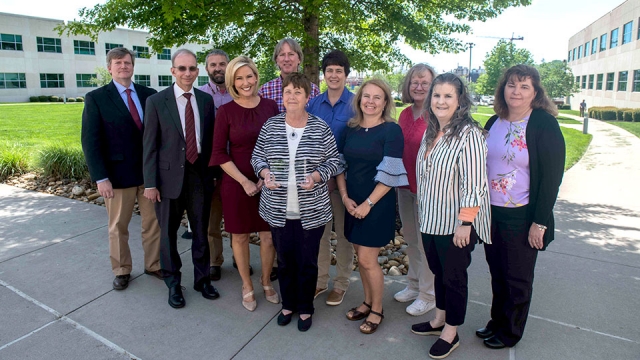 Alma Carter (center) is surrounded by her Y-12 work family and guest speaker Kristin Farley (to the left of Carter).
Alma Carter (center) is surrounded by her Y-12 work family and guest speaker Kristin Farley (to the left of Carter).
Congratulations to Alma Carter, this year’s Y-12 winner of the Jackie Kelly Award for Administrative Excellence. She’s supported Y-12’s Sustainability and Stewardship group since 2009.
“I absolutely love working with my group,” Carter said. “It brings me so much joy and satisfaction to be able to help and take care of them. I order supplies, take care of their travel arrangements, really whatever they need. I love the people I work with.”
And Carter’s group feels the same about her.
“An internal driver for Alma’s dedication and commitment to the Sustainability and Stewardship organization is her concern and caring for every employee within S&S and within Y-12,” said Jan Jackson, Carter’s manager.
“With her background as a Navy retiree and longtime Y-12 employee, she sees the importance of the work the S&S program performs in support of the Y-12 mission,” Jackson noted. “Alma is committed to ensuring that S&S and Y-12 in general ‘sparkles’ from the inside out by doing the right thing and always thinking ahead and planning to prevent issues.”
CNS established this award in 2017 in honor of Y-12’s Jackie Kelly, who met every challenge head on, including the cancer that ultimately took her life. Nominees are evaluated on performance in five categories: dedication, conscientiousness, caring, can do attitude, and capability.
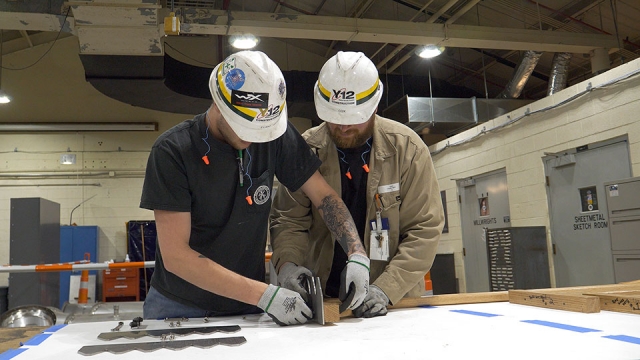 Construction employees create stainless steel rake blades to be used at Oak Ridge’s Friendship Bell Pavilion.
Construction employees create stainless steel rake blades to be used at Oak Ridge’s Friendship Bell Pavilion.
When Oak Ridge’s Friendship Bell Pavilion project was initiated, one of the proposed attractions to the site was a karesansui (pronounced car uh san swee) garden. The garden now is located in Oak Ridge at the International Friendship Bell Peace Pavilion in A.K. Bissell Park.
Karesansui gardens, a centuries-old Japanese tradition, feature sand or fine gravel raked in patterns around carefully placed boulders and stones, peaceful sites encouraging viewers to spend time in contemplation.
Pat Postma, co-chair of the International Friendship Bell Citizens Advisory Committee, created the gravel area for the garden, but she needed rakes for the volunteers to use maintaining the garden.
She asked Duane Starr, an Oak Ridge National Laboratory retiree, to design a rake, but his recommendation for the fabrication shouldn’t surprise anyone at Y-12.
“Duane came up with the idea of using stainless steel for the rake blades, thinking about durability and precision,” Postma said. Starr suggested contacting Y-12 to see if someone there could create the blades for the rakes, and Postma said CNS readily agreed.
With some 38 volunteers practiced in the art of Karesansui gardens, Postma said the three rakes provided by CNS are greatly appreciated. A smaller, second garden is being created for anyone from the community to practice raking the garden.
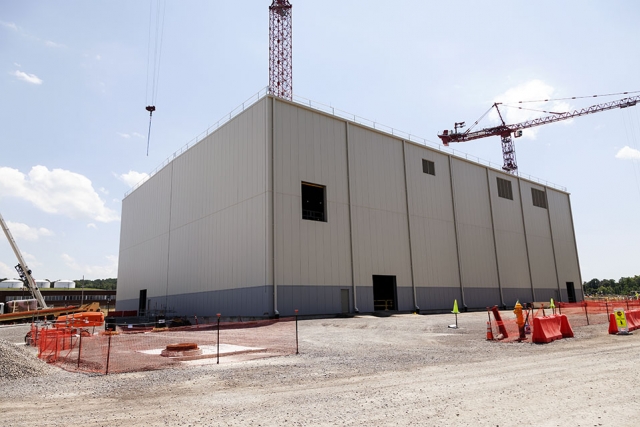 The Mechanical Electrical Building (MEB) at the Uranium Processing Facility is now “dried in”. This milestone includes installation of all siding, doors, roof, and louvers, and completion of underground utility work on the east and north side of the MEB.
The Mechanical Electrical Building (MEB) at the Uranium Processing Facility is now “dried in”. This milestone includes installation of all siding, doors, roof, and louvers, and completion of underground utility work on the east and north side of the MEB.
The Mechanical Electrical Building (MEB) at the Uranium Processing Facility (UPF) is fully enclosed and stands tall as a sign of completion amongst ongoing work areas surrounding the building. Not only was it the first main building to go vertical at UPF, it is now the first building fully enclosed and moving to the next stage of progress, which includes installation of commodities and equipment.
The shell, which includes all siding, doors, roof, and louvers, was constructed in just 310 calendar days, and is an example of why a multiple-building complex approach was used at UPF. It allows each facility to be constructed to the safety and security requirements appropriate to each building’s function. The MEB will house most of the utility equipment required for the UPF process facilities, so it was constructed to commercial standards, providing cost savings in construction and equipment installation.
“The MEB ‘in the dry’ milestone is a major accomplishment for the UPF project team,” said MEB Area Manager Misty Lawrence. “This milestone was achieved by the hard work and long hours of many individuals working together to make it possible. As we have developed lessons learned for the other UPF subprojects, we have also shown what a team can accomplish when we have a goal and work collaboratively to make it a reality.”
The next steps for MEB will be “kitting out” the building. It will be a heavy organization effort in order to complete miscellaneous steel installation; electrical installation; heating, ventilation, and air conditioning placement; fire protection; fire proofing and bulk commodity installations (i.e., spools, hangers, and valves).
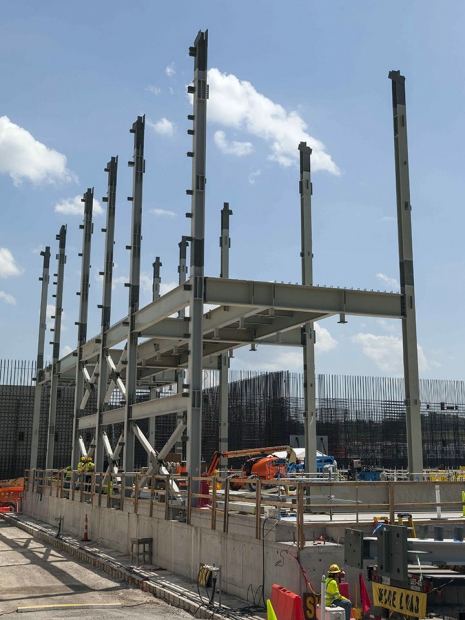 The first pieces of structural steel were installed at the Salvage and Accountability Building, marking a major milestone in the construction of the three-stories-tall building.
The first pieces of structural steel were installed at the Salvage and Accountability Building, marking a major milestone in the construction of the three-stories-tall building.
The first pieces of structural steel were installed at the Uranium Processing Facility Project’s Salvage and Accountability Building (SAB). The project team placed the building’s first four columns and four cross beams in May.
“Placing the first pieces of structural steel is a significant milestone for the project,” said SAB Federal Project Director Don Peters. “It is a visible symbol that communicates to everyone that the SAB is entering the next major phase of work. Moving forward over the next few months, all the team’s planning, preparation, and hard work will become even more noticeable as we see the building take shape.”
The steel columns currently being installed are about 60 feet tall and weigh between 10.5 and 12.5 tons each. The first phase of structural steel installation will continue over the summer and calls for almost 800 pieces that collectively weigh about 1,500 tons. The steel will be installed in rows from south to north, progressing across the building from east to west. When sufficient steel pieces have been installed, work on the second floor will begin.
At 127,000 square-feet, the three-story SAB footprint is approximately the size of one football field. It is designed to recover production chemicals and process non-destructive assays, contaminated items, and waste.
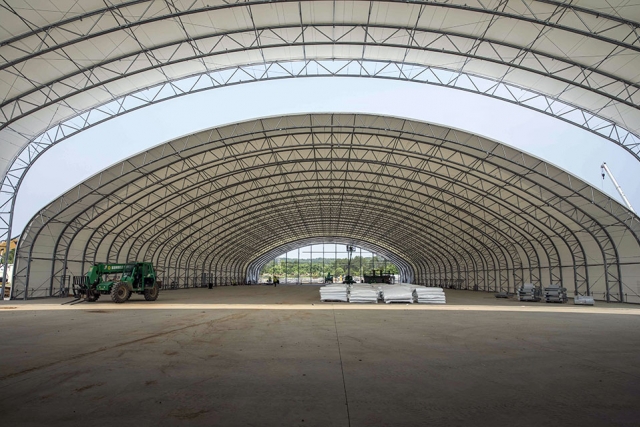 Fabric is added onto the steel frame to construct the 100,000 square foot facility that will serve as the primary fabrication area during the construction of UPF.
Fabric is added onto the steel frame to construct the 100,000 square foot facility that will serve as the primary fabrication area during the construction of UPF.
Construction has begun on the Offsite Fabrication Facility located at the East TN Technology Park. This 100,000-square-foot facility will serve as the primary fabrication area during the construction of the Uranium Processing Facility (UPF).
The Offsite Fabrication Facility will be equipped with common fabrication equipment like shears and drill presses, and include fully-outfitted welding booths, grinding booths, a paint booth, and mobile gantry cranes.
“This structure will be important throughout the construction of UPF,” said Brian Tevis, a UPF Construction manager. “Material and equipment will be brought into the facility to allow craft employees to prepare, fabricate, and install necessary materials and equipment to complete modules, racks, skids, or glove boxes.”
